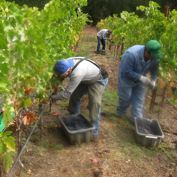 If you love wine, there is no greater pleasure than taking a trip to a winery and sampling the wine straight from the source.
If you love wine, there is no greater pleasure than taking a trip to a winery and sampling the wine straight from the source.
But, at some wineries, you can do more than just swirl and spit—you can actually go behind the scenes and really get your hands dirty.
As active, experiential travel becomes increasingly popular, more and more wine regions throughout the U.S. are offering hands-on experiences.
In California, Wine Boot Camp has one-day workshops in Napa, Sonoma, and Paso Robles.
Sonoma offers the annual Grape Camp experience that follows the grapes “from the vineyard to the bottle.”
In New York’s Niagara-on-the-Lake, Peller Estates hosts weekend boot camps that also teach wine-food pairings.
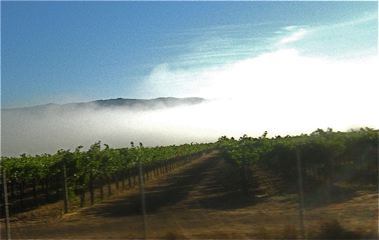 For wine lovers with ample resources, luxury travel provider Beautiful Places can provide a more private setting where you can stay in a villa in the middle of a Napa Valley vineyard and learn how to make wine with the villa’s grapes.
For wine lovers with ample resources, luxury travel provider Beautiful Places can provide a more private setting where you can stay in a villa in the middle of a Napa Valley vineyard and learn how to make wine with the villa’s grapes.
And, if you’ve really got a few thousand to spend, Destination Cellars offers exclusive access and private experiences at a variety of vineyards and wineries.
Recently, I tested out a hands-on experience as part of a three-night harvest boot camp at Hall Wines in Napa Valley. This wasn’t a series of dry presentations with a bow-tied oenophile lecturing in front of a blackboard.
During two days, Executive Winemaker Steve Leveque and Assistant Winemaker Megan Gunderson walked us through every step of the wine-making process, from picking the grapes to tasting and blending wines to create a final product.
As most wine enthusiasts and industry insiders can attest to, harvest season in premium grape-growing regions has a certain magic to it, and the excitement in the air was practically palpable.
When we were at the vineyard, Steve was debating when to pick the grapes. Checking the weather forecasts several times a day is second nature to a winemaker this time of year. Steve and Megan hoped there wouldn’t be any rain, high winds, a cold spell, or a heat wave in the next week. Just before the grapes are picked, they want steady, warm temperatures. At just the right moment, Steve will give the order to start harvesting the grapes and when he does, everyone has to be ready to work quickly.
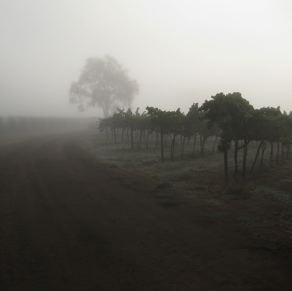 When the harvest begins in earnest, the pickers meet in the fields at 4 a.m. when the sky is pitch dark and a thick fog hangs in the air. Avoiding the heat of the day is easier on the workers and the grapes. When the flood lights are turned on, night turns into day and the workers move quickly from vine to vine, cutting off the grape clusters one by one, dropping them into their grey plastic bins (bandejas). And so the day goes, from vine to vine, then row by row, filling one bin at a time, emptying the bandejas into the micro bins that hold a half ton each.
When the harvest begins in earnest, the pickers meet in the fields at 4 a.m. when the sky is pitch dark and a thick fog hangs in the air. Avoiding the heat of the day is easier on the workers and the grapes. When the flood lights are turned on, night turns into day and the workers move quickly from vine to vine, cutting off the grape clusters one by one, dropping them into their grey plastic bins (bandejas). And so the day goes, from vine to vine, then row by row, filling one bin at a time, emptying the bandejas into the micro bins that hold a half ton each.
When the bins can’t hold anymore, they’re driven to the winery where they are emptied onto a conveyor belt so the grapes can be sorted before they move on to the distilling tanks. The wine spends up to 24 months in tanks and French oak barrels before being bottled and stored another 12 months before being released to the public.
Currently, the crews at the Hall vineyards (Sacrashe, Napa River Ranch, Bergfeld, Hardester, and Walt Ranch) are picking the grapes that will produce their 2008 Cabernet Sauvignon, Late Harvest Sauvignon Blanc, Merlot, Syrah, and Petit Verdot. Those bottles will be released in 2011.
Owners Craig and Kathryn Hall have relied on the limited production philosophy since they purchased the legendary Sacrashe vineyard in Rutherford in 1995. However, that philosophy had to expand somewhat when, a few years later, they stumbled upon the property that would become Hall Wines St. Helena. Today, Frank Gehry is designing the Visitors’ Center, and the Halls are halfway through building a state-of-the-art organic winery that will qualify for the U.S. Green Building Council’s Leadership in Energy and Environmental Design (LEED).
We arrived a few days before the really intense picking was to begin, so we were spared having to be in the fields before sunrise. But it was early enough that the fog still blocked out the morning sun. After a quick breakfast, we were driven to the Hall’s Napa River Ranch where Don Munk, the director of vineyard operations, handed out razor sharp knives that looked like miniature-scythes.
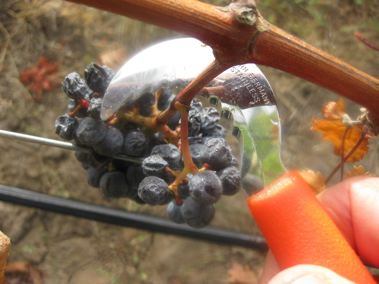 He gave us a quick lesson in the proper method of removing the grapes from the vine: one hand holds the grape cluster, while the other hand holds the knife. We were warned that the knife was sharp, so we were happy that we were also given tear-proof gloves.
He gave us a quick lesson in the proper method of removing the grapes from the vine: one hand holds the grape cluster, while the other hand holds the knife. We were warned that the knife was sharp, so we were happy that we were also given tear-proof gloves.
Don showed us to put the knife behind the stem that holds the cluster to the vine and to slide the curved blade along the stem, pulling it towards us. Then we practiced putting clusters into our bandejas, being careful to keep out leaves. Now we were ready to join the crew.
I wanted to show that I was a quick study but I quickly recognized what a novice I was. The vineyard workers moved down the rows at freeway speeds. Within minutes they quickly filled their bandejas while I progressed tortoise-like.
As we picked, we were encouraged to eat a few grapes. Steve told us, “What you taste in the grape, you’ll taste in the wine.”
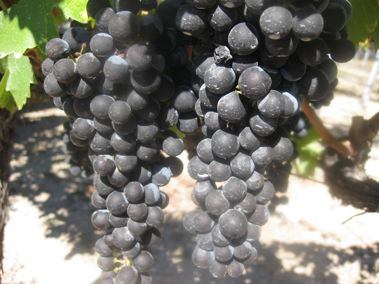 Don explained that each and every vine is “touched” seven to eight times during the year: pruning (cutting back the vines); tying the canes to the trestles; cleaning off undesired shoot growth when the vines begin to bud; leafing (thinning out the canopy so there are enough leaves to shade the grapes to prevent them from burning and turning into raisins but not so many leaves that the grapes don’t ripen); crop adjustment (thinning the grape clusters so they don’t grow on top of one another); just before the harvest, cutting off any grapes that have turned into burnt raisins; and finally just before harvest, checking the sugar content level (brix).
Don explained that each and every vine is “touched” seven to eight times during the year: pruning (cutting back the vines); tying the canes to the trestles; cleaning off undesired shoot growth when the vines begin to bud; leafing (thinning out the canopy so there are enough leaves to shade the grapes to prevent them from burning and turning into raisins but not so many leaves that the grapes don’t ripen); crop adjustment (thinning the grape clusters so they don’t grow on top of one another); just before the harvest, cutting off any grapes that have turned into burnt raisins; and finally just before harvest, checking the sugar content level (brix).
The location of the vine determines its care. If a vine has a western exposure, each cluster of grapes has to be protected from the blistering afternoon sun by a canopy of leaves, but not so much that the grapes are completely shaded. The grapes need a lot of sun but they need the right amount. Too little sun and they won’t ripen properly. Too much and they become raisins.
If unripened grapes get into the fermentation tanks, the wine will have a “green” taste. If the raisins get in, the wine will have a “prune” flavor.
After a couple of hours of picking, our group had mastered the fundamentals and our pace had quickened. Picking grapes is back-breaking work but there are tricks of the trade. We learned from the vineyard crew not to pick up our bandejas but to push them with our feet so we only had to pick up the bandejas when they needed emptying. The vineyard crew was very supportive of our efforts. They generously said we had helped them pick one and a half tons in record time.
Next we followed the grapes back to the winery and, after lunch, headed to the sorting table. Our grapes were transferred into a giant auger that moved the clusters up a three-story conveyor belt to a sorting table where we pulled off as many raisins as we could. Once sorted, the grapes pass through a sieve that separates the grapes from the stems.
We had picked Cabernet Sauvignon grapes and since red wine gets its color from the skins, the grapes were kept whole. They moved into stainless steel tanks where they would have a “cold soak” for several days.
The objective is to give the juice as much contact with the skins and seeds. At this point the mixture of juice, skin, and seeds is called the “must.” When heat is applied and fermentation begins, the skins and seeds rise to the top, creating a thick “cap” on top of the juice. Hall Wines doesn’t add commercially prepared yeasts to facilitate fermentation. Since they are dedicated to organic farming and processing, the yeast used in fermentation occurs naturally on the skin of the grapes.
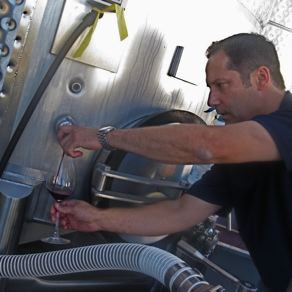 For our second day, we walked the tanks with winemakers Steve and Megan. Now we tasted samples of juice that had been in tanks 7-8 days. The stainless steel tanks were cold to the touch.
For our second day, we walked the tanks with winemakers Steve and Megan. Now we tasted samples of juice that had been in tanks 7-8 days. The stainless steel tanks were cold to the touch.
The yeast was still asleep so fermentation hadn’t started. We tasted Sauvignon Blanc juice. At this point the wine looked like unfiltered apple cider and had a slight tang. The Cabernet had the quality of thick grape juice but even at this stage we could taste the layers of flavor that would be featured in the wine.
Our next samples were from tanks that had been heated. The yeast had awakened and was happily consuming the sugar in the juice. These samples had a decidedly more alcohol kick. We knew to swish the wine around in our mouths to appreciate the flavors and then spit it out.
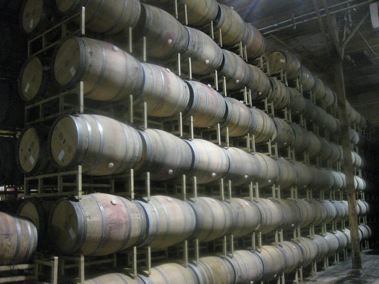 Once fermentation has finished, the wine is moved into French oak barrels.
Once fermentation has finished, the wine is moved into French oak barrels.
For the final part of our Harvest Experience, we were given a half dozen bottles of barrel sample wine from the 2007 Vintage: Cabernet Sauvignon from two different areas of the Sacrashe vineyard, Petit Verdot, Merlot, and Malbec. We were to make our own blend. We tasted each wine, made notes about flavors and alcohol levels. Then we experimented with percentages in pursuit of a perfect balance of flavors.
The only problem, as Steve had warned us, is that the flavors we wanted didn’t exist yet. We were tasting wine that wouldn’t be ready to drink for another 18-24 months.
We had to taste the wine with our mouths and our imaginations. That is the true genius of the winemaker.
By David Latt for PeterGreenberg.com. He blogs at MenWhoLiketoCook.blogspot.com.
Read more by David Latt:
- A Food Lover’s Five Easy Travel Tips
- Heathrow Offerings: Terminal 5 and Sofitel Style
- Ribs, Ribs and More Ribs: The Biggest Barbecue Cook-Off in the West
Learn about more amazing culinary travel experiences here.
Love wine? Don’t miss:












